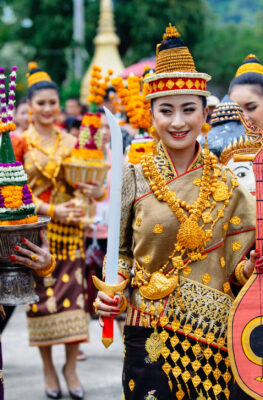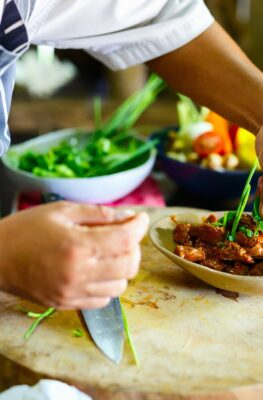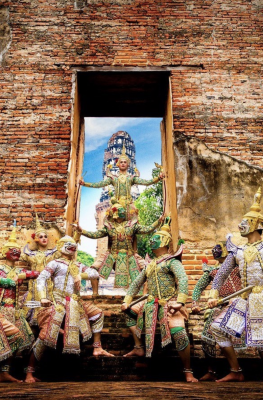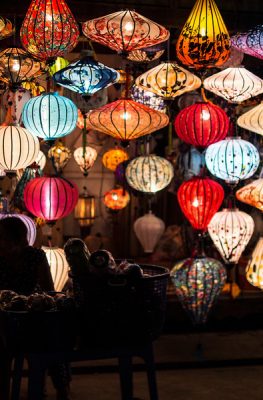Published on December 14, 2017
Durian stock at Air Itam, Penang, Malaysia. Image courtesy of Angelo Juan Ramos/Creative Commons
Don’t be fooled by the spiky shell and (to some) eye-watering pong. The durian is lovely to know, once you get past first impressions.
First impressions are hard to get over, if you haven’t grown up eating the stuff. Westerners who try durian’s creamy flesh for the first time describe the taste as something between rancid onions and week-old used gym socks. Certainly, durian eating isn’t for the casual foodie, or for palates inured to years of eating fast food and microwaved meals.
For Mark Ng, food tour group Simply Enak‘s main man in Penang, Malaysia, durian should be reserved to eaters with far more refined tastes. “It’s equivalent to blue cheese,” he explains. “Either you like it or you don’t; it’s an acquired taste.”
Bangkok, Thailand fruit market. Image courtesy of einstraus/Creative Commons
Thriving Trade
If the cheese analogy seems far-fetched to you, consider this: Thailand and Malaysia together exported over 370,000 tonnes of durian in 2015, valued at over $400 million.
Malaysia exports only a tenth of Thailand’s, but that’s because Malaysians are their own biggest customer – most of Malaysia’s durian is eaten locally.
And Malaysia’s ravenous durian-eaters have systematized their obsession down to a science. Durian fans pay top dollar for particularly delicious breeds of durian: In 2017, fans of the Mao Shan Wang breed paid about US$27 per kg of the fruit; eaters looking for the Golden Phoenix breed paid US$23 per kg.
On his home turf in Penang, Mark tells us that “there have been people trying to do tasting courses,” categorizing durian flesh not unlike how a spirits sommelier might break down a selection of bourbons: “sweet to bittersweet to bitter, like whiskey tasting from light to medium to heavy and from non-peaty to peaty and smokey,” Mark says. “It’s the same buildup.”
Opened durian with view of flesh covering seeds. Image courtesy of Francis Chung/Creative Commons
Learning to Like Durian
Before sampling a durian, you’ll need to choose a fruit – something of a tall order, when the fruit itself is encased in a hard shell with sharp thorns! Mark Ng uses old-school selection techniques that work at the majority of durian market stalls, regardless of where in Southeast Asia you happen to be:
Smell the fruit. “First of all, you have to pick up the fruit and smell it,” Mark says. “It should not smell ‘green’, and it must have some sort of strong fragrance.” Try sniffing around the seams of the fruit to catch the aroma better.
Shake the fruit. “Shaking the fruit, if it makes noise – there’s a knocking noise coming out, that tells you the fruit is dry,” Mark tells us. “That’s what you want – it’s dry, it’s not wet and lumpy. If it doesn’t have any vibration, chances are it’s very lumpy. And if you’re not the type who wants really really watery, mushy texture then that’s not for you.”
Bitter or sweet? After you’ve made your choice, there’s nothing left to do but eat – dig in and separate the creamy flesh from the seed. No two durian breeds taste the same, all the better for fans seeking variety. “Different breeds have different flavors, different textures, and different tastes,” Mark tells us. “Some people like it bitter, some people like it bittersweet, some people like it sweet.”
Bigger or smaller seeds? Certain breeds also have smaller seeds – which tells durian connoisseurs that they’re getting the best value for money. “The smaller the seed, the better, because it has more flesh [relative to the rest of the fruit],” Mark tells us; durian sellers price the fruit by the weight of the unopened fruit, meaning flesh, seeds and shell alike. “[With smaller seeds] you’re paying for the flesh; if not you end up paying more for the [inedible] seed and the shell.”
Durian seller in Hanoi, Vietnam. Image courtesy of cameroonjb/Creative Commons
Where to Buy and Eat Durian
As one of Southeast Asia’s most prized indigenous fruits, durian is grown throughout the region – the southern halves of Thailand, Vietnam, Myanmar, Cambodia and the Philippines; and the entirety of Malaysia, Singapore and Indonesia. Durian’s availability depends on the month you visit, as the durian season varies from country to country.
If you’re planning to hunt durian on your next trip, here are the countries, districts and seasons to consider before you proceed:
Thailand. Durian stalls in Bangkok take advantage of a peak season from late April to early September. Unlike Malaysian and Singaporean durian eaters, Thailand foodies “love to eat their durian unripe,” Mark tells us. “The durian they consume are quite crispy – they will harvest from the tree.”
Malaysia. Durian stalls can be found all throughout both peninsular and Eastern Malaysia. Peninsular Malaysia’s durian season takes place from late May to early September, with a second season from December to January; East Malaysia’s durian season takes place from October to February, with a smaller season from May to June.
Singapore. Durian fans in Singapore follow peninsular Malaysia’s harvest season, as most of their fruits come from right across the border.
Philippines. Durian mainly grows on the southern island of Mindanao – the durian sellers in Davao City sell during a peak season of August to November that coincides with the Kadayawan Festival.
Indonesia. Durian stalls at the capital Jakarta sell at their peak from October to February; the durian-growing island of Sumatra has a different harvest season from June to September, something to consider if you’re visiting the island’s biggest city Medan.
Brunei. The fruiting season in Brunei lasts from July to November; when in Bandar Seri Begawan, visit the Pasar Malam Gadong (Gadong Night Market) to get your durian fix. The market is open from 4pm to 11pm.
Vietnam. The fertile plains between Hue and Ho Chi Minh City produce bumper crops of durian between May and July.
Cambodia. The May-July durian harvest season is good news for the durian-growing region of Kampot, Cambodia’s much-vaunted “durian capital”.






